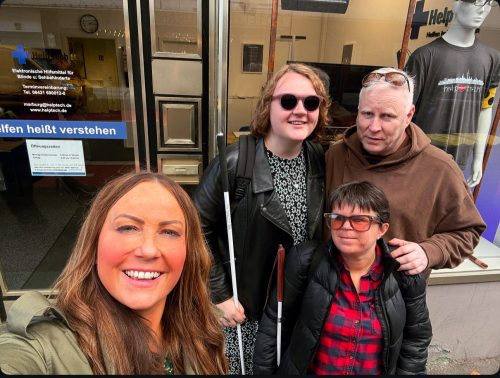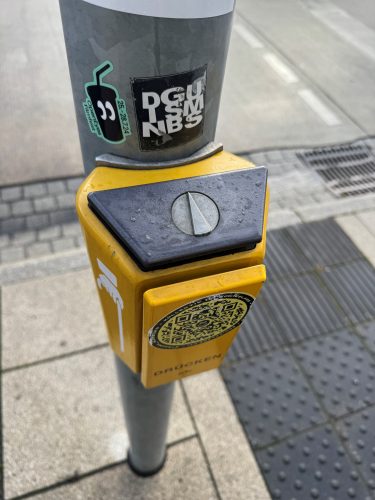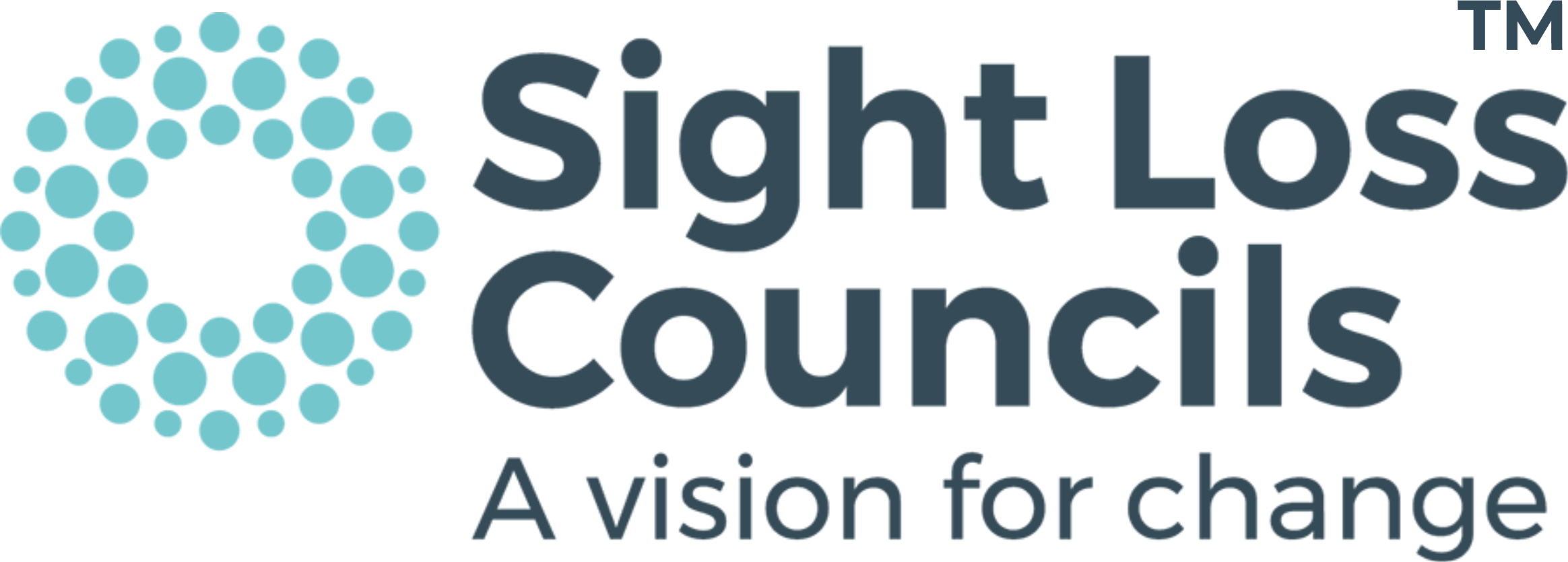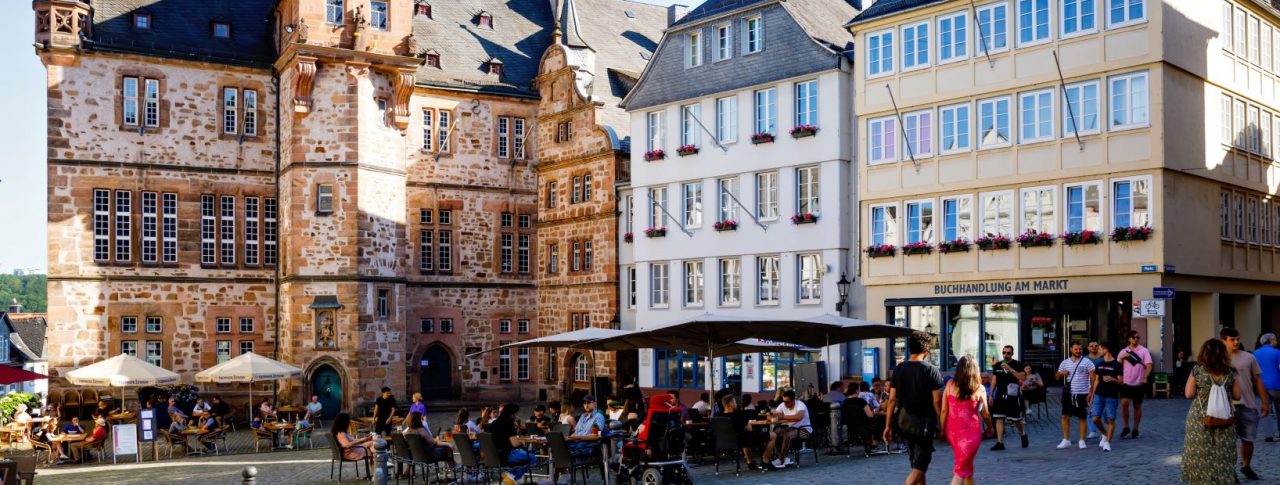Sight Loss Councils explore the accessible town of Marburg
In November last year, colleagues from Sight Loss Councils (SLCs) and Thomas Pocklington Trust (TPT) explored the accessible city of Marburg, Germany, to learn more about its approach. Marburg is known as ‘The City for the Blind’ as a result of its commitment to inclusivity for blind and partially sighted (BPS) people. Thomas Pocklington Trust’s Head of Engagement, Rachel Wilkinson, gives an account of what they learnt from the trip.
“After reading about it online, a few representatives from TPT, including myself, were lucky enough to visit this inspirational town. This was to learn more about inclusivity and accessibility.
Marburg is a picturesque medieval town in the heart of Germany, situated about 90 minutes from Frankfurt.
Not only is Marburg known for its rich history and vibrant community, it’s also recognised for its exceptional inclusivity and accessibility for blind and partially sighted people.

TPT’s Rachel, Iain, Martha and Sydney taking a selfie outside the Tech Help shop
What makes Marburg an exemplary model for cities striving for inclusivity for blind and partially sighted people?
Historical Commitment to Accessibility
Marburg has a long-standing commitment to accessibility, dating back to the establishment of the German Federal Association of the Blind and Visually Impaired (DBSV) in 1912. Similarly, the ground-breaking educational institute for the Blind, the Blindenstudienanstalt (or Blista) was founded there during World War One, to provide opportunities for young men blinded in the war.
This historical dedication has laid a strong foundation for the town’s ongoing efforts to create an inclusive environment. These initiatives are not seen as revolutionary but are embedded into the town’s infrastructure as accessibility priorities.
Comprehensive infrastructure
Marburg boasts a comprehensive infrastructure designed to cater to the needs of blind and partially sighted people. The town’s public transport is equipped with tactile guidance systems, audible signals, and Braille signage. This ensures that visually impaired individuals can easily navigate the city.
The town’s streets and public spaces are also designed with tactile paving and contrasting colours to aid those who are partially sighted. As a result, residents and visitors enjoy an unparalleled sense of freedom and independence.

Crossing with wayfinding arrow and vibrating case
Community and support networks
The sense of community in Marburg is one of its most compelling attributes. The town is home to numerous support networks and advocacy groups. These organisations work tirelessly to promote the rights and well-being of blind and partially sighted (BPS) people.
These organisations provide a range of services, including counselling, peer support, and recreational activities, enhancing a strong sense of belonging and empowerment. Marburg has created a culture of support and understanding amongst its citizens.
Cultural and recreational activities
Marburg offers a rich array of cultural and recreational activities that are accessible to all. The town’s museums, theatres, and cultural centres are equipped with audio guides, tactile exhibits, and Braille materials. This ensures that BPS people can fully engage with the town’s cultural heritage.
Additionally, Marburg designs its parks and recreational facilities with accessibility in mind, offering opportunities for outdoor activities and social interaction.
Iain Mitchell, Senior Engagement Manager for Sight Loss Councils in Yorkshire and Humberside, shared his thoughts on how Marburg’s emphasis on community support, ground-breaking infrastructure and accepting attitude creates a society where BPS people can thrive independently. He explained:
“In the short time we were there, we counted well over 20 cane users and around five guide dog owners, confidently navigating around the city. All of them walking around independently, without the need for a sighted companion and going out socialising in groups.
“Sighted residents were supportive and understanding, always giving BPS people priority when crossing the road or boarding a bus. In shops and restaurants, staff were confident in their interactions with BPS customers, never patronising or being unaware of the needs some may have.“
Marburg, Germany, stands as a beacon of inclusivity and accessibility for BPS people.
Its historical commitment to accessibility, comprehensive infrastructure, strong initiatives within community support, plus the advancement in delivering accessible cultural and recreational activities make it an ideal destination for BPS people.
As other cities look to enhance their inclusivity efforts, Marburg serves as an exemplary model of how to create a welcoming and supportive environment for all residents and visitors.
Furthermore, by continually prioritising accessibility and inclusivity, Marburg not only improves the quality of life for its visually impaired residents but also sets a standard for other communities and countries to follow.
What can we learn about improving accessibility from Marburg?
Iain added that true change for minority groups comes from a societal shift towards inclusivity and acceptance. He said:
“The only effective way to create meaningful and positive change for minority groups, I believe, is through cultural change.
“By that, I mean the journey taken by society to change a set of values and beliefs from one position into a more inclusive and accepting understanding of need. It may start with empathy but ends up being normal practice, instinctive and without debate. Is this a utopian ideology?”
How do other countries compare in terms of inclusivity and access? This month TPT launched a new report focused on international inclusive approaches for BPS people focused on education and employment.
We recommend this report as an excellent read. It provides a thorough overview of accessibility and inclusion for BPS people on an international scale.”
Download the ‘Understanding International Approaches to Achieving Equality of Blind and Partially Sighted People’ report via the TPT website.
Publication date: 30 July 2025

